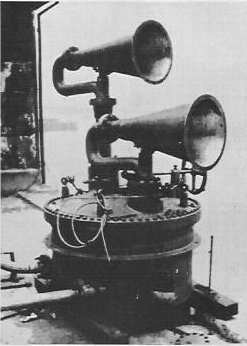![]() The Pacific War Online Encyclopedia
The Pacific War Online Encyclopedia
|
| Previous: Type 21 General Purpose Radar | Table of Contents | Next: Type 32 Fire Control Radar |

Nakagawa (1993).
Fair use may apply.
| Wavelength | 10 cm |
| Pulse Width | 10 microsecond |
| Pulse Repetition Frequency
|
2500 Hz |
| Scan rate | 5 rotations per minute |
| Power | 2 kW |
| Range | 20 nautical miles (35 km) aircraft group 10 nautical miles (17 km) single aircraft 13 nautical miles (24 km) battleship |
| Antenna |
Horn |
| Display |
A scope |
| Accuracy | 220 yards/3 degrees 200 meters/3 degrees |
| Resolution | 1600 yards/40 degrees 1500 meters/40 degrees |
| Weight |
2910 lb (1320 kg) as
installed on surface ship 4717 lb (2140 kg) as installed on submarine |
| Production: | 300 sets. Fitted to modern destroyers in summer 1942, to Kongo-class battleships 1942-10, to light cruisers 1943-6, to the Yamatos 1943-10, and to other destroyers 1944-9. |
The Japanese Type 22 radar,
also known as Mark 2 Model 2, saw wide operational use in the war,
being installed on surface ships and submarines. Though nominally
a surface search radar, it was also used for air search and for fire control. It was based
on an early Japanese version of the cavity magnetron, the M-312,
used 40 vacuum tubes, and had limited power. Quality control
during production was a serious problem: Of the first sixy sets
built, only about six actually worked. The chief difficulty was
achieving adequate precision in machining the oddly-shaped
cavities in the M-312 magnetron to achieve the precise frequency
required to match the magnetron with the M-60 vacuum tube used in
the receiver.
The first set was tested in October 1941 and a pre-production version called the Model 103 was experimentally shipped on Hyuga just before the battle of Midway. With its dual steerable horn, it was nicknamed "Bluefin Tuna" or "Horse Mackerel." Mass production was authorized by the end of 1942 but no materials were allocated. One of the Army technicians on the project proceeded to acquire materials through the black market, which led to some of the accountants on the project being arrested and held by the police for a month. Its first operational triumph was allowing the evacuation flotilla for Kiska to navigate under cover of heavy fog. Because of continuing difficulty matching components, production never came close to the target of 150 sets a month.
An improved version, the Mod 1, with a more stable heterodyne
receiver, was rushed to the fleet in time for the Battle of the Philippine Sea. Another
version, the 22-Kai-3, was designed for submarines and differed in
having a pulse repetition rate of 600 Hz.
References
The Pacific War Online Encyclopedia © 2007, 2009-2010, 2013 by Kent G. Budge. Index